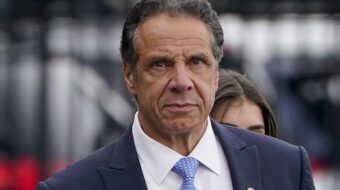
Opponents of real health care reform are now zeroing in on how it will be financed. They are arguing that universal health coverage, especially a public plan, is too expensive or, if they can’t block a public option, that it should be paid for by working class Americans through a tax on their existing health coverage.
In other words, anything but the plan approved by two House committees, which would tax the rich.
The House plan would provide universal health care including a public option, and cover half of the $1 trillion price tag through a surcharge on the tiny group of wealthiest Americans.
Rupert Murdoch’s New York Post last week featured a front-page headline proclaiming “Dem health Rx a poi$on pill.” The story and accompanying graphic claimed that the tax the rich plan would hurt typical New Yorkers like the “Single Wall Streeter Earning $285,000,” or the “Married Couple with Combined Income of $1.5 Million.”
But those scary “facts” turn out not to be facts, Tim Foley points out in his change.org blog. The Post suggests the Wall Streeter faces a sharp surtax of $2,850. In fact, notes Foley, “Wall Street Dude’s surtax is only on the income above $280,000. His surtax is $50. That’s not a typo. $50.”
As to small businesses, writes Foley, the House health care reform bill, by including small business tax credits, “will actually pay out to small businesses more than it takes in — to the tune of $53 billion over 10 years.”
Finally, the millionaires, like the couple cited by the Post as typical New Yorkers, “represent 0.27 percent of households in this country,” Foley notes. “They’re households that have done precipitously well over the past 10 years while wages for everyone else have flat-lined.”
The House legislation proposes a 5.4 percent surtax on that tiny group.
In all under the House Democratic plan, just 1.2 percent of the nation’s households would pay any surtax whatsoever, notes Sam Pizzigati of the Campaign for America’s Future. For many of these households, the surtax would be modest, he writes. Families making $500,000, for instance, would pay just 0.3 percent of their total annual income, about $1,500 in surtax.
Economist Josh Bivens of the Economic Policy Institute writes that income of the top 1 percent in our country has been growing steadily over the past 30 years, about 40 to 80 times faster than the “bottom” 90 percent. So any income lost by this tiny group of the richest Americans because of the new tax surcharge “would be made up in a matter of months,” he writes.
In other words, Bivens says, “what is essentially being asked is for the top 1 percen of incomes and above to delay a pay raise for somewhere between 1 to 9 months.”
“Given that 80 percent of the private sector workforce has seen no raise at all since December of last year, it seems hard to make the case that the nation’s richest households cannot give up a few monthly raises of their own if it can make a serious dent in paying for fundamental health reform.”
In this context, proposals to tax employee health benefits — a tax increase that would especially hit union members — seem highly suspect.
Economist Dean Baker points out that “the vast majority of the people who benefit from the tax deductibility of employer-provided health insurance do not earn more than $250,000. Most are solidly middle-class, many of them are union members.”
“Many middle-class union members could be looking at tax hikes in the neighborhood of a $1,000 a year” if so-called “gold-plated” benefits were taxed, according to Baker.
Further, Elise Gould, the Economic Policy Institute’s director of health policy research, demolishes the mythology that’s being propagated that America’s union members are awash in luxurious health coverage.
“Many of the people who pay the most for health insurance have benefits that are far from gold-plated,” she writes.
“High premiums are found among small businesses, not because the plans are especially lavish, but because they have high administrative costs and include too few employees to constitute the broader risk pool that would qualify them for lower premiums.
“High premiums are found in companies with older workers because those workers are expected to have higher health care costs.
“The high price of these plans may not stem from any bells and whistles in their coverage but rather from a fundamental inequity in the way that insurance is currently priced.”
Rather than putting the burden on union workers, Baker suggests several other ways to finance universal health care:
• “Create a public health care plan that will engage in ruthless cost-cutting and the most aggressive competition possible with private plans. … The message to private insurers would be to get costs down or go out of business.” But, he warns, “the private insurers are a powerful lobby that will fight to the death to protect the $200 billion in unnecessary costs it imposes on the economy.”
• Get rid of the patent monopolies that make prescription drugs and medical equipment expensive. This could save more than $200 billion a year, he says, suggesting that other more efficient means of financing the research and development of new drugs can be identified.
• “Pay our doctors salaries that are more comparable to what doctors earn in other wealthy countries, which could also save us close to $100 billion a year.”
suewebb @ pww.org
Corrected version. An earlier version of this article incorrectly identified health care blogger Tim Foley.










